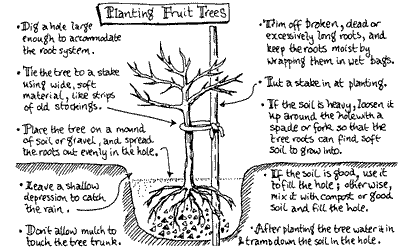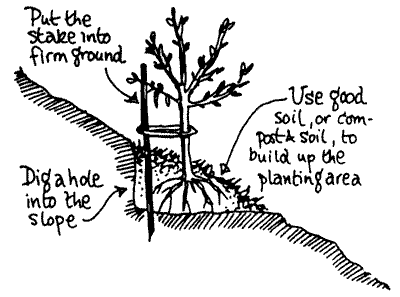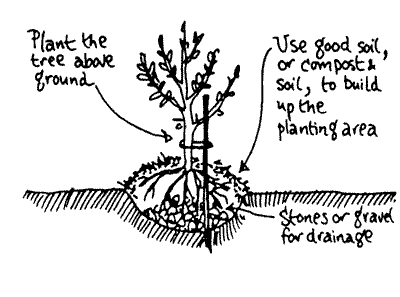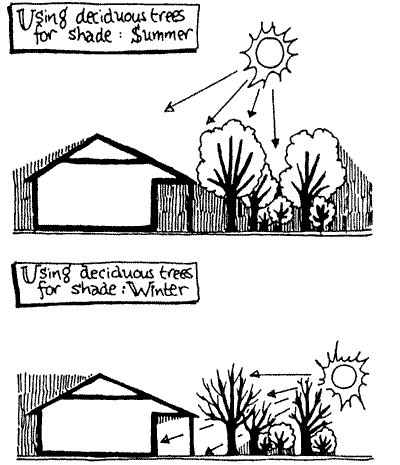
PLANTING FRUIT TREES
This article is aimed at helping you to improve your success rate when planting fruit trees. It's been adapted by Sandra Clayton from her book "The Reverse Garbage Garden" (published by Hyland House and featured in Earth Garden Reviews, EG 86)

Few fruit trees are propagated by seed. Seedlings are too variable for it to be worthwhile. Most are propagated either vegetatively or by a combination of seed and vegetative means.
The most common method is for seedlings to be grown as rootstock (seed) and for a good fruiting variety to be grafted or budded on to it (vegetative). Few fruit trees take well from cuttings. Aerial layering is one way to propagate fruit trees vegetatively.
Grafted named varieties can be bought from local nurseries or by mail order. Deciduous trees are planted in winter when dormant and need to get into the ground as soon as possible. If planting is delayed, heel the trees in. This means digging a narrow trench, putting the tree roots in and covering them with damp sand or soil. Alternatively, the roots can be covered with soil above ground. Roots must not dry out. When trees are being planted, cover the roots with a moist hessian bag.
Evergreen trees, like citrus, are best planted in autumn or spring.
The planting hole has to be large enough to take the whole root system, so dig it at least a metre by a metre and maybe half a metre deep. If the drainage of your soil is poor, plant trees into raised beds or put stones or tiles in the bottom of the hole.
 |  |
TRIM DAMAGED ROOTS
Trim off damaged roots, then spread the roots out in the hole. Put in a stake or two and fill in the hole. Water the soil and stamp it down firmly with your feet. Make sure the graft is above ground (it is a lumpy bit on the trunk). Leave a slight depression around the tree to catch rain and tie the tree to the stake(s).

All fruit trees need to be mulched. Grass, hay, leaves, seaweed, stones and weeds are all good. Materials too rough to use in garden beds, like bracken and slabs of bark, are fine. Include animal bedding and manure. Don't let mulch touch the trunk. Lime, urine and wood ashes are also good.
Fruit trees must be protected from animals. They are attractive to cattle, goats, horses, possums, rabbits and wallabies. Some animals improve the trees if given limited access. Poultry reduce pest infestations by cleaning up fallen fruit, although hens scratch up the mulch (stone mulch stops this). Ducks eat lots of insects in the grass.
Possums, rabbits and wallabies can totally destroy fruit trees, so fence appropriately. Each tree can be individually fenced or the whole area fenced as a unit. Tyres around young trees protect them from rabbits. Stack two tyres up around the tree. Herbs and small fruit can be planted inside protective fencing around trees. Blood and bone or fresh blood can be tried as a rabbit and wallaby repellant.
If your garden space is limited, try planting dwarf varieties and remember that close planting will dwarf all trees to some extent.
Fruit trees can be interplanted with bushes, herbs, shrubs, small fruit, vegetables and vines. Mixed plantings provide good returns and tend to confuse insect pests while harbouring a wide variety of beneficial species.
DATE: July 1994
* * * * * * * * * * * * *
